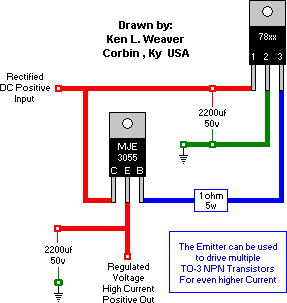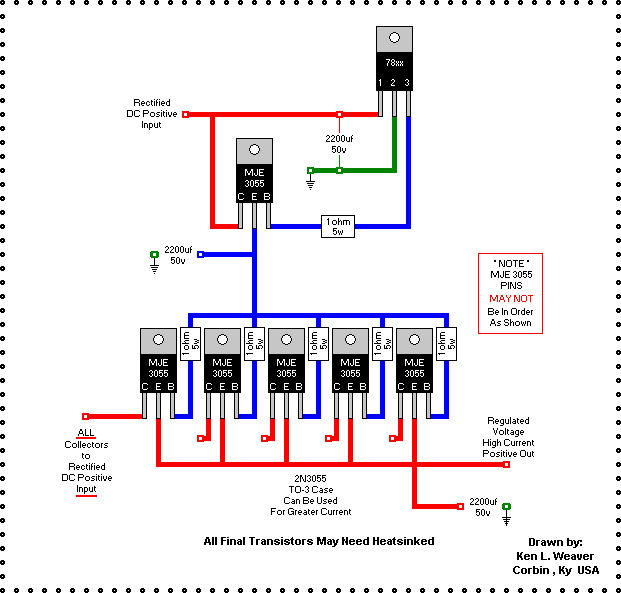Yes, these voltage drops are completely normal and, in fact, lower than I would expect.
This circuit is very simplistic, consisting merely of two cascaded emitter follower stages, one with a single MJE3055 and a second with five MJE3055s. There is no overall feedback to tightly control the output voltage which will vary with load current (and temperature).
For driving a fan, the absence of feedback probably does not matter. There will be some uncompensated dependence of output voltage on load current, but does that matter for your application? (By the way, what kind of fan draws 30 amps at 12 volts DC and why does the voltage have to be regulated?)
Part of the voltage drop you are seeing is due the the Vbe (Voltage base-to-emitter) that you will find in the MJE3055 data sheet. The data sheet (
http://alumni.cs.ucr.edu/~sneema/mje3055t.pdf) says, "[VBE (on) *Base-Emitter On Voltage @ VCE = 4V, IC = 4A is 1.8 V]." This means that the voltage drop from base to emitter is 1.8 volts with an emitter current of 4 amps and with a voltage of 4 volts from collector to emitter. They note that this is tested with pulses of 300 msec duration in a pulse train of 2% duty cycle. Testing this way minimizes transistor heating during the test.
Since you are observing only about 0.3 volts from base to emitter, I presume that you are not testing at 30 amps into the load. Vbe is somewhat dependent upon emitter current, but not in a direct ohmic manner.
Another part of the voltage drop you are seeing is due to the ohmic voltage drop in the 1 ohm resistors in series with each MJE3055 base. This can be roughly calculated by assuming a typical value for the current gain of the MJE3055. The spec sheet gives a range of current gains from 20 to 100 at 4 amps and a minimum of 5 at 10 amps emitter current. If you are drawing 30 amps from 5 transistors, that's roughly 6 amps for each transistor, assuming equal sharing of the load current which assumes well-matched MJE3055s. Figure 1 of the spec sheet shows a typical current gain of 30 at 6 amps. That means your base current is roughly 6/30 = 0.2 amps for each output MJE3055. 0.2 amps through 1 ohm = 0.2 volts drop across each base resistor. That will show up as a 0.2 volt drop in the output voltage in addition to the Vbe drop. You can perform a similar calculation for the single MJE3055 driving the 5 bases.
All in all, not a very sophisticated circuit, but simple and possibly ok for driving a fan. Output voltage control is very unsophisticated. The 78xx puts out a nominal voltage of xx volts. The single driver MJE3055 emitter voltage will be xx volts minus (Vbe + the driver stage base resistor drop). The emitter voltage of the five output MJE3055s will be the emitter voltage of the driver stage minus (Vbe + the average output stage base resistor voltage drop).
To obtain reasonably equal sharing of load current between output transistors they should all be from the same production lot so their characteristics are well matched. Poor matching of output transistors could result in poor load sharing and possible sequential burnout of all output transistors.
You can compensate for the cumulative voltage drop by substituting an adjustable three-terminal voltage regulator for the 78xx or by inserting a few forward-biased small-signal diodes between the "ground" terminal of the 78xx and circuit ground.
awright



